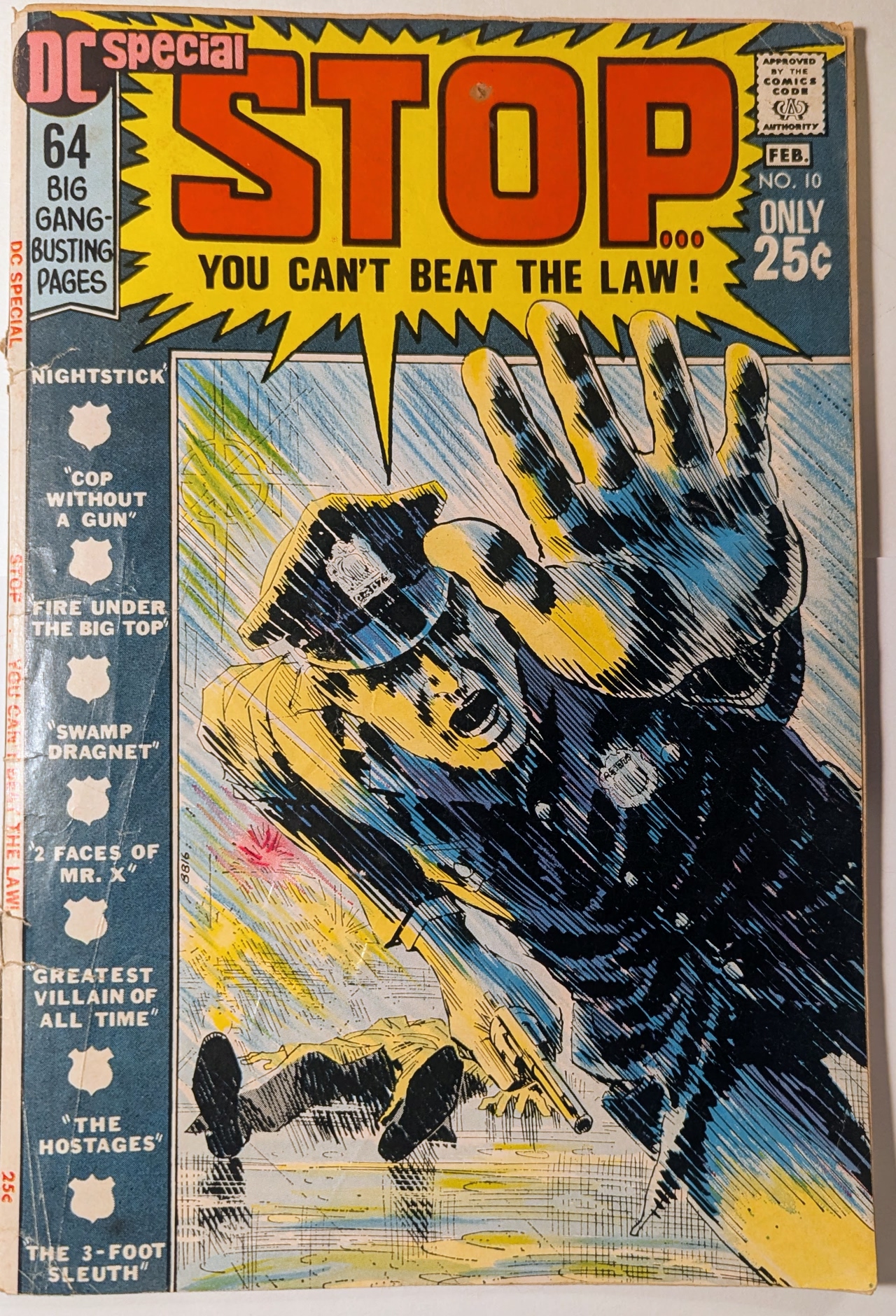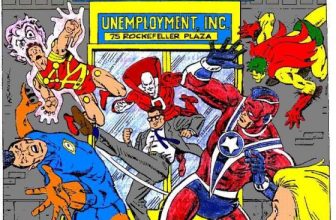
Wow, it’s been a long time since I’ve written anything for this blog that I’m still paying for. It’s been almost three years, and I have to admit—I’m disappointed in myself for that. I’ve read a lot of good comics over the past couple of years—plenty of great ones, in fact. Many of them made me want to sit down and write, but, as the last post from 2022 shows, I didn’t follow through—until today.
In 2023, I started tracking the comics I read, listing them in spreadsheets — because I like lists and data. I enjoy being able to look back and figure out when I last read an issue of Daredevil, or how many years after buying Phantom Stranger #32 I finally got around to reading it. I even started setting goals for myself. That comes with its pros and cons, but one clear upside is that it’s helped me read comics aligned with the monthly themes created by the comics community I’m proud to be a part of.
It’s May, and that means it’s Crime Comics Month—#crimecomicsmonth.
Which brings me to DC Special #21: Stop! You Can’t Beat the Law!. One thing that’s changed about my comic reading is that I’ve grown to appreciate and enjoy more Golden Age stories. I used to avoid anything that predated the story Flash of Two Worlds, thinking the writing wasn’t as engaging and the art wasn’t great. But, like many things that change as we grow older, so did my appreciation for these stories.
As I bought more and more reprint and anthology series from the seventies—titles like From Beyond the Unknown—and spotlight series like DC Special, I began exposing myself to more Golden Age material. But these weren’t just any Golden Age stories.
Series like From Beyond the Unknown were created to repurpose stories the comic companies already owned and give them more exposure to new readers. At the time, comic collecting was still a burgeoning hobby. Only die-hard fans kept the old comics they read, and there were no comic shops yet. For the average 12-year-old picking a comic off the rack, these stories were brand new. They were top-quality selections, chosen by editors to be reprinted for a fresh audience. Fifty-four years later, they’re still brand new to a fan like me.
DC Special—not to be confused with DC Special Series—ran for 29 issues and featured a wide range of themed comics. There are spotlight issues on Carmine Infantino and Joe Kubert, one focused on female heroines, another with all Viking Prince stories, and several issues devoted to strange sports stories and The Three Musketeers. For May, I decided to read the issue made up entirely of reprints focused on crime, the police, and one bonus story featuring brave firefighters.
Since this was still the early seventies, creator credits weren’t something publishers cared much about—and this book is no exception. There’s a table of contents that provides a summary and title for each story, but no credits for writers, artists, or original publication sources. According to Comic Vine, many of the stories originally appeared in various issues of Gang Busters, while the remaining ones came from Showcase. The site also includes a list of creators who worked on them. Some of the biggest names of the era contributed to these stories—creators like Arnold Drake (creator of Doom Patrol), Curt Swan (longtime Superman artist), and the ever-reliable Nick Cardy, just to name a few.
While I’m not going to recap all the stories in this “gang-busting” 64-page comic, there were a couple of highlights I’d like to discuss.
Nightstick – originally printed in Gang Busters #33
The lead story is called “Nightstick”, and the Grand Comics Database lists Curt Swan and Ray Burnley as the artists, with no writer credited. This police adventure follows a third-generation beat cop who must work over Christmas without access to modern tools available to other officers—things like a teletype machine, a squad car, or a shortwave radio.
Thomas Farraday begins his shift after having Christmas Eve dinner with his family. Before he leaves, his grandfather reminds him not to forget his nightstick. This particular nightstick was used by both Thomas’s father and grandfather. Grandpa then proceeds to tell Thomas how important the nightstick is—as both a symbol of duty and a weapon to subdue criminals.
While on patrol, Thomas walks past a jewelry store and notices a car parked out front, which seems odd at that hour. When he doubles back for a closer look, four armed men exit the store carrying satchels, presumably filled with stolen merchandise. Farraday startles the criminals, who immediately draw their weapons. Before he can raise his pistol, one of the robbers shoots him in the arm. Thomas drops his revolver but manages to climb into the back of their speeding truck.
Injured but determined, Thomas clings to the back of the box truck, waiting for it to stop. When it finally does, he sneaks around the side of the vehicle, wielding only his nightstick, and catches the gang off guard. Despite his injuries, Thomas puts up a fight, but the robbers eventually overpower him and knock him to the ground. Thinking quickly, he hurls his nightstick through a nearby store window, setting off an alarm. This alerts nearby police officers, who arrive in time to save Thomas and arrest the gang.
The moral of the story is that a good policeman doesn’t need modern gadgets like squad cars to be effective. Strength, quick thinking, and a trusty nightstick are enough to get the job done. What stood out to me most about the story was its simplicity and the excellent artwork. The art is engaging, detailed, and dynamic. The character designs are sharp, and the action sequences are exciting.
Fire Under the Big Top – Originally printed in Showcase #1
“Fire Under the Big Top” showcases firefighters instead of police—and, as you might guess, it takes place at a circus. The story begins with Officer Fred Farrell reporting to his new commander, Lieutenant Reiner, for fire inspection duty. Since the circus is in town, Farrell and the Lieutenant visit the owner to ensure everything is up to code. Naturally, the inspectors find problems—the most serious being that the circus doesn’t have a licensed pyrotechnician to run the fireworks show scheduled for the end of the night.
Lieutenant Reiner tells the owner to get a licensed technician on-site or the show is canceled. He then heads back to the office, leaving Farrell to finish the rest of the inspection. Farrell loses track of time, and before he realizes it, evening has arrived and the circus is preparing for the big fireworks show. An errant rocket misfires and strikes the roof of the main tent, igniting a fire. Panic erupts, and chaos spreads as the flames grow. Firefighter Fred Farrell keeps his cool, directs people to safety, calls for the fire engines, and works to contain the situation.
The next problem: the animals are loose. The fire engines arrive just as Caesar, the star male lion, breaks free—scared and lashing out. Thinking quickly, Farrell knocks Caesar out with a high-powered hose. While this may seem harsh, the story assures us the lion is unharmed, and Farrell even expresses regret, saying he didn’t want to hurt the animal.
The next problem: the animals are loose. The fire engines arrive just as Caesar, the star male lion, breaks free—scared and lashing out. Thinking quickly, Farrell knocks Caesar out with a high-powered hose. While this may seem harsh, the story assures us the lion is unharmed, and Farrell even expresses regret, saying he didn’t want to hurt the animal.
With things coming under control at the big top, the firefighters are alerted to another emergency at the far end of the fairgrounds—where the rides are located. The fire is spreading toward the wooden roller coaster. All the circus goers have been safely evacuated when suddenly they spot Toby, a baby elephant, climbing the roller coaster tracks, trying to escape the flames. At first, it seems like they may have to shoot the elephant to spare him from a worse fate, but once again, Farrell jumps into action.
He climbs the wooden coaster to reach Toby and works to calm the frightened elephant. He then calls for the ladder truck and instructs the crew to attach a harness to the end of the ladder. Once the harness reaches him, Farrell secures it around Toby, and the firefighters carefully maneuver the baby elephant to safety.
Lieutenant Reiner congratulates Farrell, saying he took a big risk to save one animal. Farrell thanks his commander, saying that all life is important—even that of a circus elephant.
Similar to Nightstick, this story is very engaging and features excellent artwork. What struck me most was the care and compassion shown by these brave men among men. There’s no chest-beating or over-the-top macho attitude—just a clear, heartfelt message: all life is worth saving.

Wrap up
There are several other good stories in this issue, and I think it’s worth seeking out if you enjoy simple, fun Golden Age crime stories. Swamp Dragnet, a tale where the police team up with park rangers to catch thieves hiding out in a swamp, offered a fresh twist and was a lot of fun. Cop Without a Gun showed that a police officer doesn’t need to use a weapon to do their job well.
All the stories are six to eight pages long and feature some of DC’s top talent from the era. One of the things that makes these stories worth reading is that they don’t glamorize law and order or preach to the reader about behaving—or else the police will come after them. Instead, they’re simple tales about individuals trying to do good. They’re adventure stories meant to inspire children’s imaginations.
There’s no need to question the characters’ motives—these aren’t stories about corruption or injustice. They’re about right and wrong, about caring for our animal friends as much as our fellow humans. They don’t glorify the characters just because they’re police officers or firefighters, and I appreciated that while reading this comic.
One final note, I did use an AI app to proof read and suggest improvements to my original draft. The tool was a big help fixing mistakes and did assist me with improving what I had writing.














